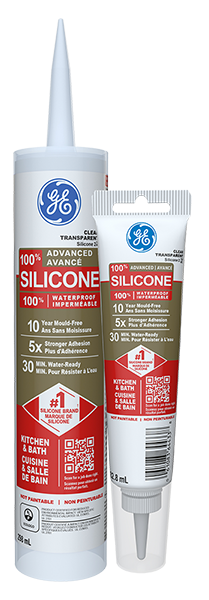A bathtub should be able to stand up to humidity, splashes and the occasional overflowing bubble bath, and to do that, it needs a durable seal. Not only does it look unpleasant, but old tub sealant that’s cracked or peeling can let water and moisture into your walls, creating serious problems like mold, mildew and rot. To prevent these problems, it’s important to replace old sealant with a new, 100% silicone seal.
Tools & Supplies for Sealing Bathtubs
Picking the right sealant can make all the difference. For sealing a bathtub, or anywhere water could be present, choose a GE-branded 100% silicone sealant, like GE Advanced Silicone 2® Kitchen and Bath sealant. This sealant is 100% waterproof, permanently flexible, has 10-year mold-free product protection1 and excellent adhesion for a watertight seal.
Pro Tip: 100% silicone sealants are not paintable so be sure to pick the appropriate color for your project.
Besides a GE-branded 100% silicone sealant, you will also need:
- Caulk gun
- Painter’s tape
- Latex gloves
- Soapy water
- Paper towels
- Utility blade
- Caulk tool
- Mineral spirits
- Isopropyl alcohol
With the right tools and sealant for your project in hand, follow these steps to learn how to seal a bathtub so it’s completely waterproof and mold-resistant for years to come:
-
Start with a Clean Surface
Whenever you start a new sealing project, make sure you have a clean work surface by wiping it down with isopropyl alcohol. If you’re replacing a seal, completely remove the old caulk or sealant, then wipe down the area with isopropyl alcohol. Let the surface dry before laying a new bead.
Safety Tip: Make sure your work area is well ventilated when using isopropyl alcohol.
-
Apply Painter’s Tape
For a smoother bead and easier cleanup, apply painter’s tape on either side of the area you’re sealing.
Pro Tip: When sealing certain types of bathtubs, such as fiberglass tubs, you may want to fill it with water before applying sealant. Tubs will naturally sink and flex from the weight of the water, putting stress on the sealant joint. If you fill the tub before applying the sealant, you can account for this stress and ensure the finished seal will properly expand and contract when you fill and empty the tub in the future.
-
Carefully Cut the Sealant Cartridge
Next, prepare your sealant by cutting the tip of the cartridge. Cut the cartridge tip at a 45-degree angle. Some caulk guns have a tool to cut the cartridge tip, but we recommend using a utility blade for consistently clean results. Cut off less than you think you’ll need because you can always cut more. Once cut, pierce the cartridge’s inner foil seal using the metal rod on your caulk gun or a long nail. Then load the cartridge into the caulk gun.
-
Apply Sealant
Once your area is prepped and your sealant is ready, seal around the tub where it meets the wall. Start running a bead of sealant at the edge of the tub and work your way inward. Pull the gun toward you while maintaining a relaxed grip and steady speed. If you can’t make it in one pass, it’s ok to readjust your grip and start where you left off. Fill gaps with additional sealant as needed.
-
Tool the Bead & Remove the Painter’s Tape
Use a caulk tool or your finger to tool the sealant bead until it’s smooth. Because it’s important to tool the bead before the sealant starts to cure, it may be better to work in sections. Apply sealant along one side of the tub, tool the bead, then continue onto the next side.
-
Let Sealant Cure Completely
Finally, allow the sealant to cure completely for the best performance. GE Advanced Silicone 2® Kitchen & Bath sealant is water-ready in 30-minutes2 and fully cured in 24-hours, but check your product for specific curing instructions.Now you know how to seal a bathtub with the help of high-performing GE-branded sealants. For more step-by-step sealing tutorials, check out our other How-To guides.
1Cured sealant is resistant to stain causing mold and mildew. Regular cleaning of the cured sealant is required, however, as soap and other residue can cause secondary mold and mildew growth.
2Exposure to water possible in as little as 30 minutes with bead size max 3/16”, temperature min 65℉ and humidity min 50%. Otherwise, sealant should not be exposed to water for 8 hours. Do not touch or clean sealant for 24 hours.

